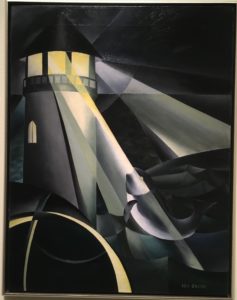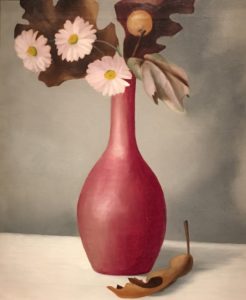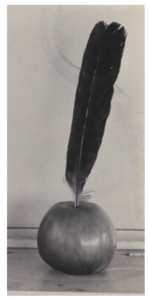This past weekend, the Massachusetts Medievalist journeyed to the northwest corner of the state for the Clark Art Institute’s exhibit, “Ida O’Keeffe: Escaping Georgia’s Shadow.” The small, chronologically arranged exhibit includes numerous interesting and engaging works, most especially six of the seven paintings in O’Keeffe’s “Lighthouse” series that she painted in Provincetown MA 1931-1932.

I was also struck by the still lifes, especially the 1927 “Peach-blown vase,” with its intriguing mixture of techniques and composition. The paintings on display left me somewhat unsatisfied, wanting to see more of the work of this artist who seemed to experiment with a variety of styles and palettes without settling into one.

The feminist historian in me, however, disagrees with the narrative presented by the exhibition. Signage and labels show Ida’s attempts to move away from “Georgia’s shadow,” note the varieties of paid employment she performed, and ultimately define her as a minor artist who never found her own style (conclusions drawn, somewhat more harshly, by Roxana Robinson in the New Yorker).
Most egregiously, the exhibit refers to the relationship of Ida and Alfred Stieglitz, Georgia’s husband and Ida’s brother-in-law, as “flirtatious” and full of “sexual innuendo.” Stieglitz’s photo of Crow’s Feather and Apple is included as a visual example of this “flirtation”:

With Stieglitz himself as the feather and Ida as the “Ida Red” apple. The photograph was made in 1924 when Ida was “visiting” Georgia and Alfred in the summer between teaching jobs.
So here’s my version of the narrative:
Like many unmarried, middle-class professional women of her era, Ida O’Keeffe participated in a sexist, impoverishing version of the gig economy, cobbling together teaching jobs, nursing positions, and editorial work to try to pay her basic expenses. In the summer of 1924, when she was between jobs and had no other place to live, a “visit” to her sister and brother-in-law entailed her endurance of Stieglitz’s deeply inappropriate and aggressive, predatory behavior. The split between the sisters – often discussed in terms of Georgia’s desire to be the only serous artist in the family — was exacerbated by Georgia’s willful ignorance about her husband’s harassment of her sister. Without hardly any financial and professional support, Ida was unable to focus on development of her artistic technique and style; she spent much of her adult life moving around the country to various teaching and nursing positions, fitting her painting and exhibiting around the non-artistic work that paid the bills.
Ida O’Keeffe is then indicative of probably thousands of women whose talent was stifled by masculinist culture in general and that of the art world in particular — #TimesUp for Stieglitz the entitled creepy predator, and time to celebrate Ida O’Keeffe, whose few remaining works, provocative and somewhat haunting, painfully remind us of her unrealized ambitions.
